The United States has established itself as an unrivaled leader in the North American e-commerce logistics market. This success is primarily driven by its cutting-edge technologies and robust infrastructure. Online sales in the country have experienced remarkable growth over the past decade, registering an impressive annual increase of 13% to 18%. This remarkable trajectory is projected to continue, with experts forecasting a steady compound annual growth rate (CAGR) of over 6% from 2023 to 2028.
Parcel Monitor, our data and research arm, collects billions of anonymized data points from more than 130 countries annually. This data is harmonized with data from hundreds of millions of parcels from over 1500 carriers to generate insights into the US market. Here are some key findings from the latest report:
- Steady growth in e-commerce sales: The upward trend is expected to continue with a CAGR of over 6% between 2023 and 2028.
- Innovation in e-commerce logistics: Automation in warehouses and distribution centers has improved the speed and accuracy of fulfillment.
- Shorter parcel transit times: Transit time in the US declined from 3.5 days to 2.19 days in 2022.
- High first-attempt delivery success rate: First-attempt delivery success rate increased from 83% to 98% in the US in 2022.
- Most delivery issues are carrier-related: 82% of delivery issues encountered by merchants and customers in the US were caused by carrier-related factors.
- Decline in collection point usage: A decline in collection point usage suggests consumer preference for cost and speed over sustainability.
- Cost and speed are top priorities: Less collection point usage means businesses should prioritize these factors to stay competitive.
- Lack of product information an issue: 42% of US consumers cited the lack of product information as a barrier to buying.
- Decline in peak season parcel volume growth: Attributed to possible increase in spending at brick-and-mortar stores.
- Peak season parcel transit time performance drop: Top 4 US carriers report longer transit times during Black Friday Cyber Monday (BFCM) weekend of 9%-37%.
- Most time spent in the first and middle mile: During peak season, parcels were mostly stuck at the first (70.6%) and middle mile (84.3%) of the delivery process.
The e-commerce landscape: Innovation is paving the way for future growth
During the challenging lockdown, e-commerce logistics thrived while other businesses struggled. Many offline customers transitioned to online shopping, enabling e-commerce logistics to grow. The US, the second-largest e-commerce market in the world, adopted innovative technologies to enhance efficiency and customer experience.
Automation in warehouses led to faster and more accurate fulfillment logistics. As per LogisticsIQ’s latest market research study, the Warehouse Automation Market will reach $30 billion by 2026, at a CAGR of around 14% between 2020 and 2026.
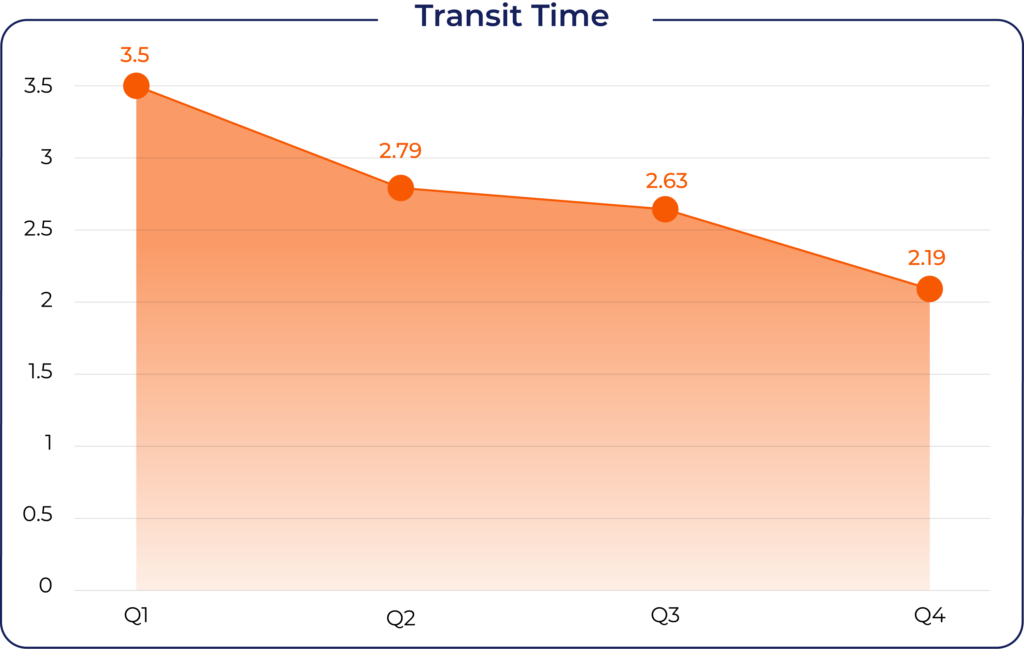
According to our internal data, parcel transit time in the US dropped from 3.5 days in the first quarter of 2022, to 2.19 days in the last quarter. For customers, shorter transit time means receiving their orders sooner, which can result in higher satisfaction. For businesses, shorter transit times can lead to higher order volume, as well as cost savings on transportation and logistics in the long run.
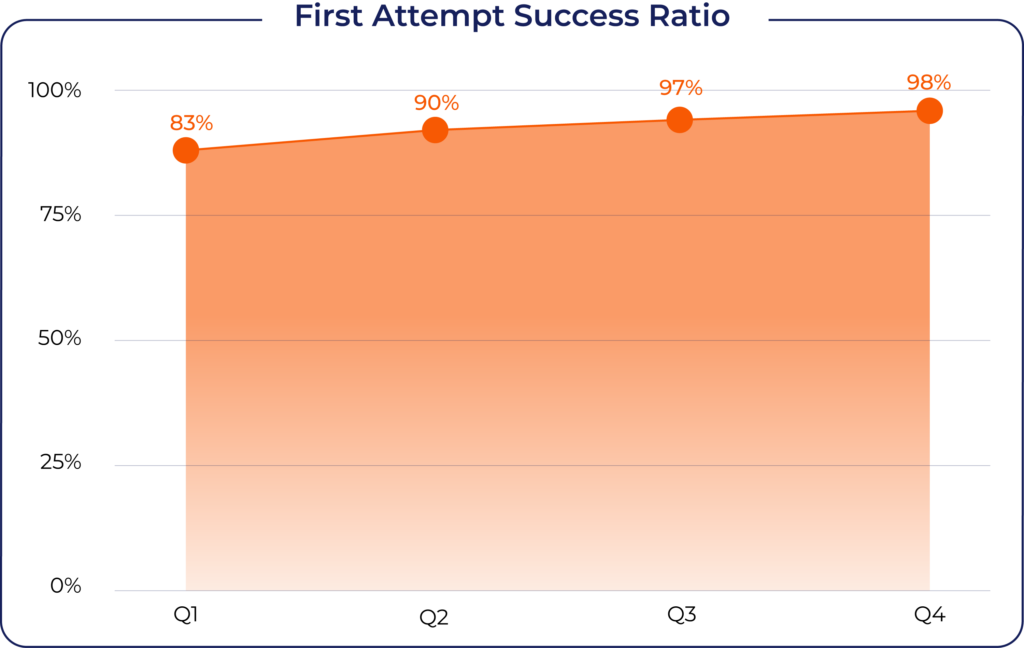
Successful first-time deliveries are vital for customer satisfaction in retail and e-commerce. Our data shows a steady increase in the first-attempt success rate of parcel deliveries from 83% in Q1 2022 to 98% in Q4 2022, and equalizing at 95% in H1 2023. Improved communication between delivery companies and customers, such as providing more accurate estimated delivery dates and real-time tracking updates, may have contributed to this improvement.
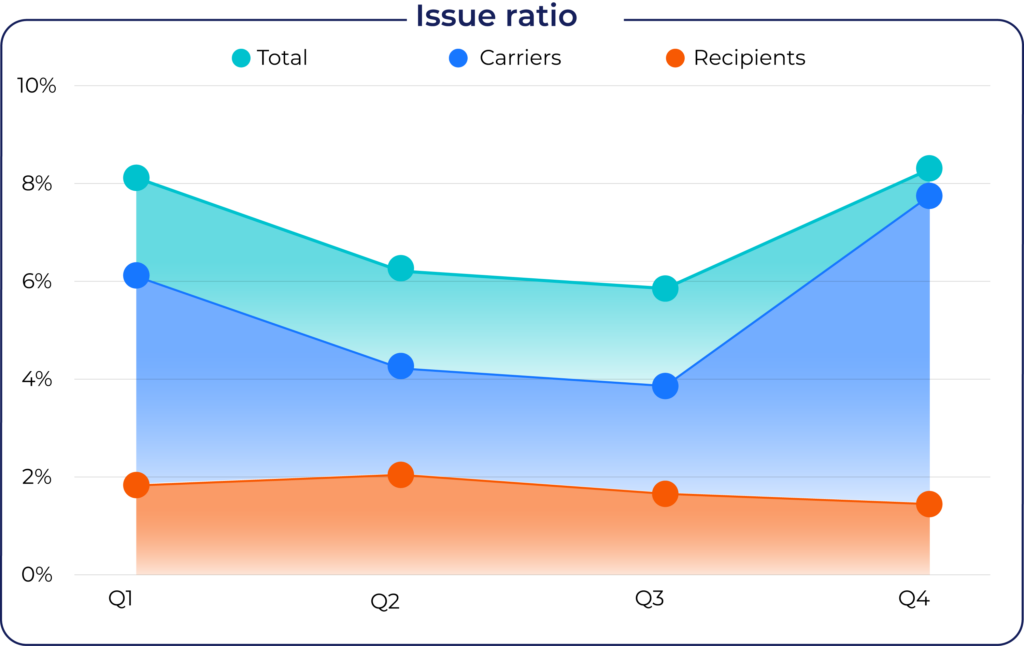
Delivery issues typically fall into two categories: either on the recipient’s side (e.g. not being present to receive the package) or the carrier’s side (e.g. not providing timely notifications about the package’s whereabouts). In 2022, carrier-related factors were responsible for approximately 82% of the delivery issues in the United States. This could indicate a dire need for businesses to conduct data-driven analysis on their choice of carriers or third-party logistics providers.
US consumers prefer cost, speed, and convenience
Sustainability in logistics fulfillment is growing, leading to alternative last-mile delivery methods. Collection point usage in the US fluctuated, dropping from 2.9% in H1 2022 to 2% in H2 2022, then rising to 3.18% in early 2023. Dwell time also increased from 49% to 52%.
Parcel lockers and collection points are a more sustainable way to get packages to customers. However, they also need to be accessible and convenient or consumers will avoid using them. Collaborating with local businesses can not only help in identifying suitable locations but also establish mobile collection points to meet demand.
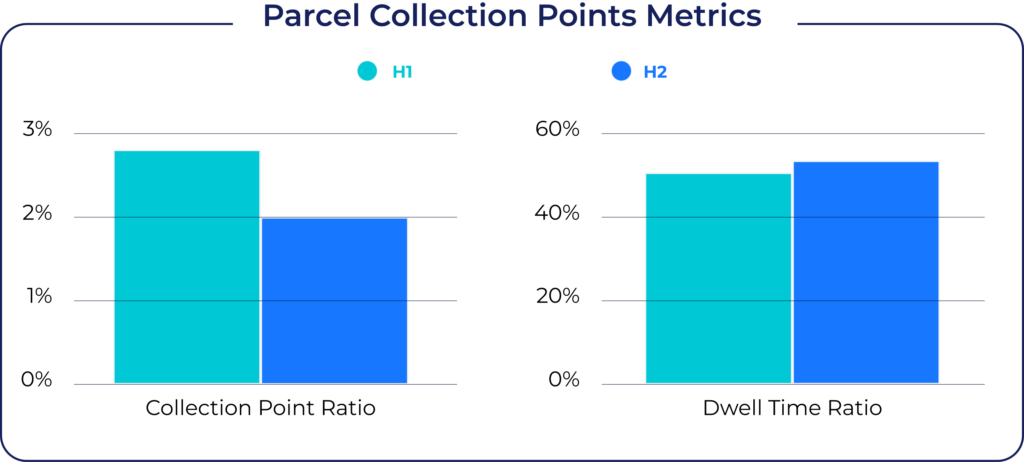
According to Rakuten Insight Global’s recent survey, consumers in the US tend to value cost and speed above all else when it comes to delivery experiences. This suggests that in order to remain competitive and meet the needs of this group, businesses have to prioritize cost and speed while also taking sustainability and convenience into consideration.
When asked about their frustrations with online shopping, 42% of US consumers highlighted “lack of product information” as the biggest issue. With a vast number of products available on the e-commerce market, it can be challenging for consumers to make informed decisions without adequate product information. This lack of information can potentially lead to purchasing products that do not meet their needs.
Other notable pain points that US customers face include a lack of user-friendly websites (38%), limited inventory visibility (38%), slow or inadequate customer support (34%), and a shortage of payment options (17%). These challenges can significantly affect the customer experience and result in frustration, leading to lost sales for e-commerce businesses.
Top four US carriers better equipped for upcoming peak seasons
Despite lower volume projections, major delivery firms prepared for the 2022 peak season by hiring seasonal workers. UPS planned to hire 30,000, similar to previous years, while USPS hired 10,000 and converted 150,000 pre-career positions to full-time jobs.
Efforts were made to strengthen logistics infrastructure and technology. USPS invested $40 billion in new equipment and enhancements, increasing its daily processing capacity to 70 million packages in 2023 from 60 million in 2022.
In terms of infrastructure and technology, USPS invested $40 billion into 395 new package processing equipment and operational precision enhancements, which were projected to increase daily processing capacity to nearly 70 million packages in 2023, up from 60 million in 2022.
Increasing consumer preference for seamless omnichannel experience
In our last post-peak review, we noticed e-commerce growth in Europe and the US slowed during peak season 2022. In the US, parcel volume growth dropped from 42.9% in 2021 to 18.9% in 2022. This was mostly due to consumer spending shifting from online retailers to brick-and-mortar stores.
In an NIQ survey, 80% of respondents said they purchased something in-store during this period. This could explain the decline in e-commerce parcel volume growth despite a significant rise in total retail sales.
However, in 2023, 49% of NIQ survey respondents said they often use both online and offline channels for shopping. This suggests that e-commerce growth is stabilizing and merchants are adapting so they can cater to shoppers through both channels.
US carriers experience peak season speed bumps in the first and middle mile
During BFCM 2022, there was an increase in transit time for parcels across all four major carriers in the US. This was within expectations, given the surge in e-commerce orders around this period.
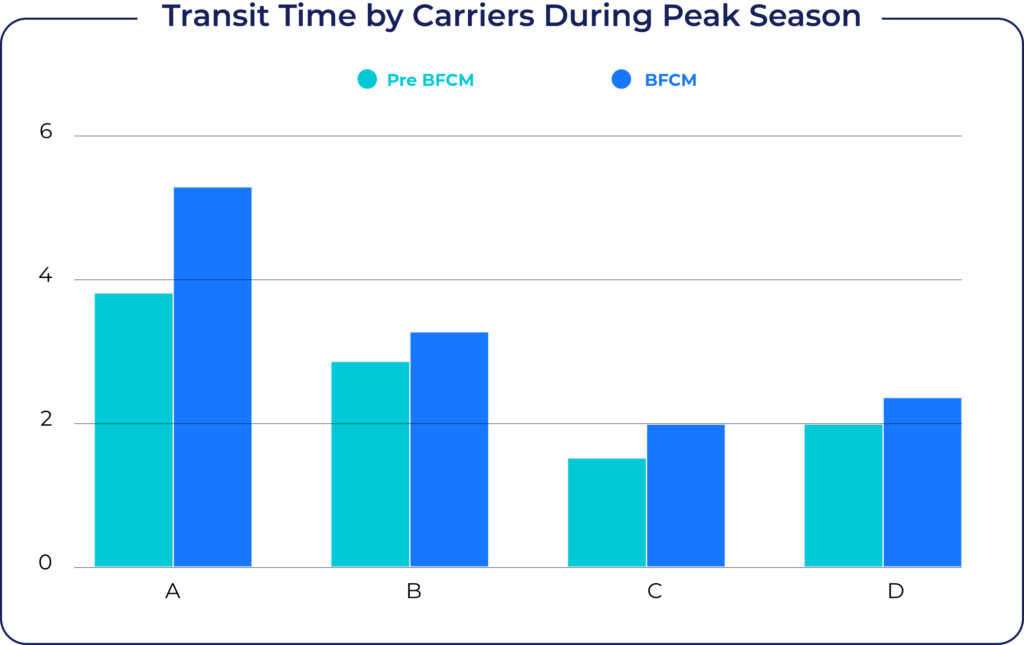
In e-commerce logistics, the average time for goods to be transported from a merchant to consumers is referred to as the fulfillment duration. Parcels spend most of their time in the first and middle miles of delivery (70.6% to 84.3%), despite the last mile being the most expensive.
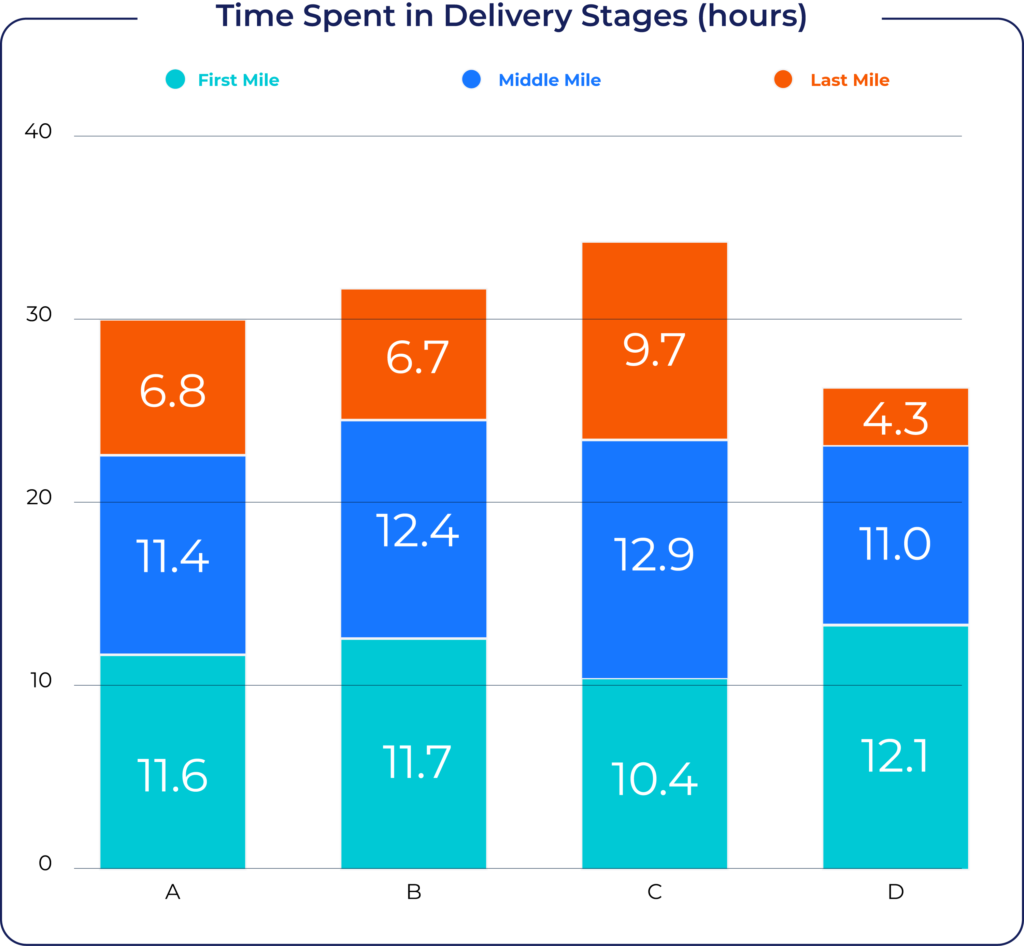
Among the top four US carriers analyzed, Carrier B had the longest duration (24.1 hours) in the first two delivery stages during peak season 2022. Carrier C had the longest last mile duration (9.7 hours), while Carrier D had the shortest (4.3 hours).
Preparing for future peak seasons with logistics data
The insights we shared can be instrumental in understanding your markets better. But to leverage these insights, you would need to analyze your own logistics data. To do so, you would first need to consolidate data from your end-to-end logistics process and make this data readily accessible from a unified view.
Once you have a unified view of your logistics data, you can start to use it to improve your efficiency and effectiveness. After capturing post-purchase data and making it readily available in a simple platform, you get a holistic view of logistics operations and customer interactions. With this data at your fingertips, you unlock the potential to optimize four experiences in your business.
- Checkout experience: Logistics data can be used to provide transparency into the post-purchase process. It arms customers with critical delivery information such as estimated delivery dates (EDD), and the best route options. Giving customers this information helps build trust, and gives customers the confidence to checkout–which translates to a reduction in cart abandonment and higher conversions that drive revenue growth.
- Delivery experience: Make real-time tracking information easily accessible by your customers. This can be done via delivery update notifications, or even self-service tracking portals on your website. Doing so can help to improve customer satisfaction, customer retention, and reduce the likelihood of involuntary returns. It also provides your business with a direct channel to your customers that can be used for brand awareness and upselling.
- Returns experience: With data, merchants have the ability to automate a large part of the returns process, such as approvals. It also gives customers the option of performing frictionless self-service returns — starting from choosing refund alternatives, to generating return labels and returns status tracking. This can help to reduce the costs and hassles of returns, improve customer satisfaction, reduce “where is my refund” (WISMR) inquiries, and recapture revenue.
- Logistics experience: Logistics data — when consolidated and readily available from a single platform — has the biggest impact on your logistics operations. It enables your logistics teams to optimize complex multi-carrier operations, gauge and benchmark performance, and proactively identify and resolve potential bottlenecks. With full visibility over carrier costs and performance metrics, you’re able to choose the best carrier partners for your e-commerce business.
Each individual experience contributes to the overall e-commerce post-purchase experience. However, when these experiences are combined with a unified data platform, e-commerce enterprises can unlock true business transformation. Instead of making incremental improvements, your business becomes better positioned to create the seamless and convenient post-purchase experience that customers want.
Data is the ideal co-pilot for your e-commerce business
Data unveils the hidden potential and visibility of each experience in your business, especially in post-purchase logistics. With an end-to-end platform, you gain real-time data insights from alerts, advanced reporting, and analytics. Your logistics team can proactively address delivery issues by setting alerts for delays and resolving them before they affect other deliveries.
You can also ensure carrier reports align with actual performance by comparing their reports against your data. This is crucial when working with multiple carriers as each measures performance differently. Furthermore, you can derive insights from trends and patterns to understand your delivery performance, customer behavior, and market trends.
This non-siloed information drives strategic business decisions that enhance your competitive advantage and growth. Here’s how logistics data improves post-purchase operations:
- Data-driven decisions: Consolidating data offers a clear view of your logistics operations, transforming complex data into actionable business intelligence.
- Proactive problem-solving: By standardizing carrier reporting formats, you can automate alerts for any issues, allowing immediate focus on resolutions.
- Tracking carrier performance: Monitor the performance of your carriers to identify deviations from service levels and ensure you pay only for delivered services.
Simply put, the US e-commerce market is growing rapidly, with a projected value of $755 billion by 2025. This growth presents opportunities for businesses. However, consumer preferences are changing. Businesses need to use logistics data to meet the unique demands of consumers.

Walter Heil is Senior Vice-President, Americas, at Parcel Perform. If you have any questions about our report or want to learn more about our Parcel Perform Data and Delivery Experience Platform, please contact us.


